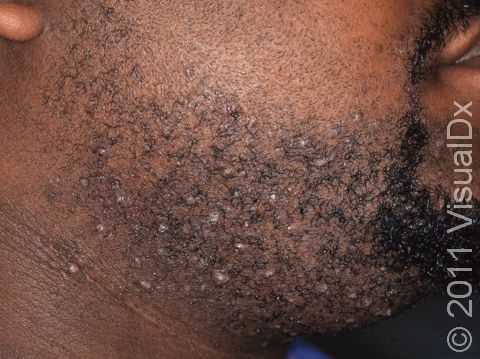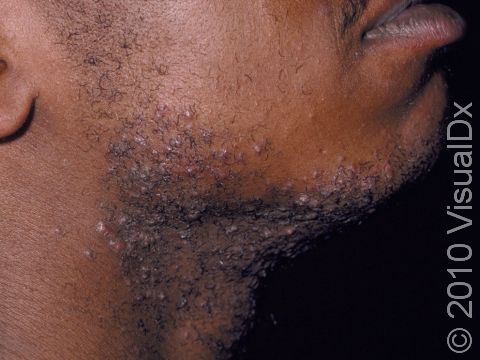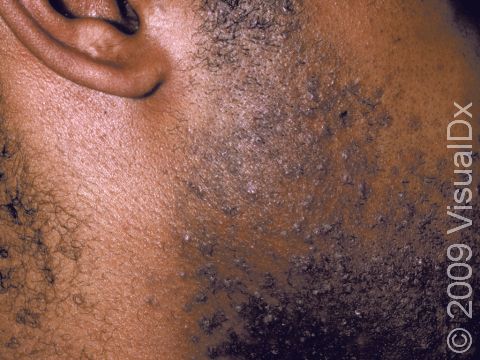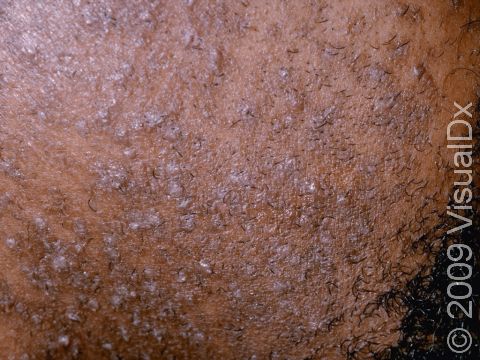Razor Bumps (Pseudofolliculitis Barbae)
Razor bumps (pseudofolliculitis barbae), also known as shaving bumps, particularly affect people with tightly curly hair who shave their beard area. After shaving, when the tip of hair grows back under the skin or into the hair follicle, it is known as an ingrown hair. If the ingrown hair causes a reaction in the skin following shaving the area, it is known as razor bumps. The condition is not an infection but rather an inflammatory reaction. Razor bumps may be worsened by methods used to achieve a close shave, such as pulling the skin tight while shaving, shaving against the direction of hair growth, or using multiblade razors.
Who's At Risk?
Razor bumps most commonly affect Black men who shave, but anyone with curly beard hair can be affected. Up to 80% of Black men have this problem. Razor bumps may also occur in men or women who shave or pluck hair or undergo electrolysis.
Signs & Symptoms
Papules (small, raised bumps) or pustules (small, pus-filled bumps) occur in the shaved area (typically the beard area), often with a hair visible in the center. In darker skin colors, the lesions may appear red, purple, gray, or any shade of brown, whereas in lighter skin colors, they are most often skin-colored or red.
Self-Care Guidelines
An effective solution to razor bumps is to let the beard grow. Once the hairs grow long enough, they will not grow back into the skin. If you must continue shaving, initially let the beard grow for 30 days to eliminate ingrown hairs. Then, to avoid ingrown hairs in the future, you can try the following:
- Use an electric shaver, as they do not cut as close as blades do.
- If you must use a blade, before shaving, wash the face with a mild cleanser, then rinse. Massage the beard area gently in a circular motion with a warm, moist, soft washcloth. This will free up the hair tips so they can be cut with the shaver. The warm water will also soften the hairs, making them easier to cut. Lather the beard area with a nonirritating shaving gel and shave in the direction of beard growth. After shaving, rinse thoroughly with warm water and apply a mild moisturizing aftershave lotion.
- Use a razor with a single blade. Razors with multiple blades cut the hair too short, allowing it to grow inward.
- Shaving every other day, rather than daily, will help. Do not pull the skin taut while shaving with a razor blade.
- At night, apply a lotion containing glycolic acid to the affected areas. This exfoliates the surface skin cells and reduces the likelihood of new razor bumps.
Treatments
- Tretinoin (Retin-A) cream used at night.
- Eflornithine (Vaniqa) cream to try to reduce hair growth.
- Topical or oral antibiotics to help treat any associated infection.
- Laser hair removal may be the most effective measure.
Visit Urgency
If none of the self-care measures help and you must continue shaving, seek medical help.
Trusted Links
References
Bolognia J, Schaffer JV, Cerroni L. Dermatology. 4th ed. Philadelphia, PA: Elsevier; 2018.
James WD, Elston D, Treat JR, Rosenbach MA. Andrew’s Diseases of the Skin. 13th ed. Philadelphia, PA: Elsevier; 2019.
Kang S, Amagai M, Bruckner AL, et al. Fitzpatrick’s Dermatology. 9th ed. New York, NY: McGraw-Hill Education; 2019.
Last modified on May 16th, 2023 at 5:11 pm

Not sure what to look for?
Try our new Rash and Skin Condition Finder



